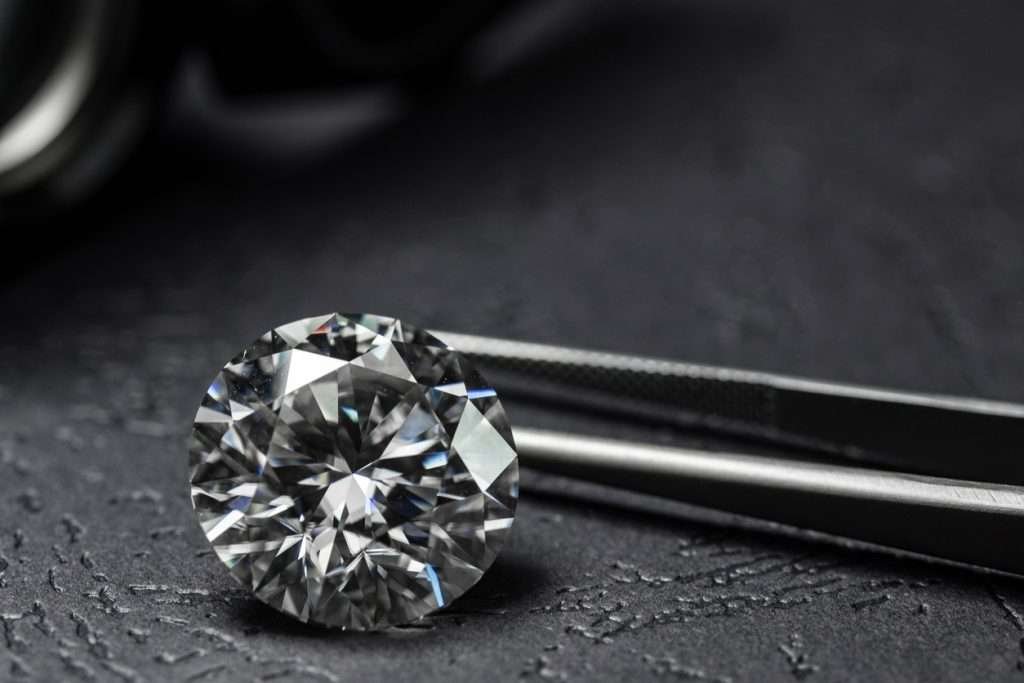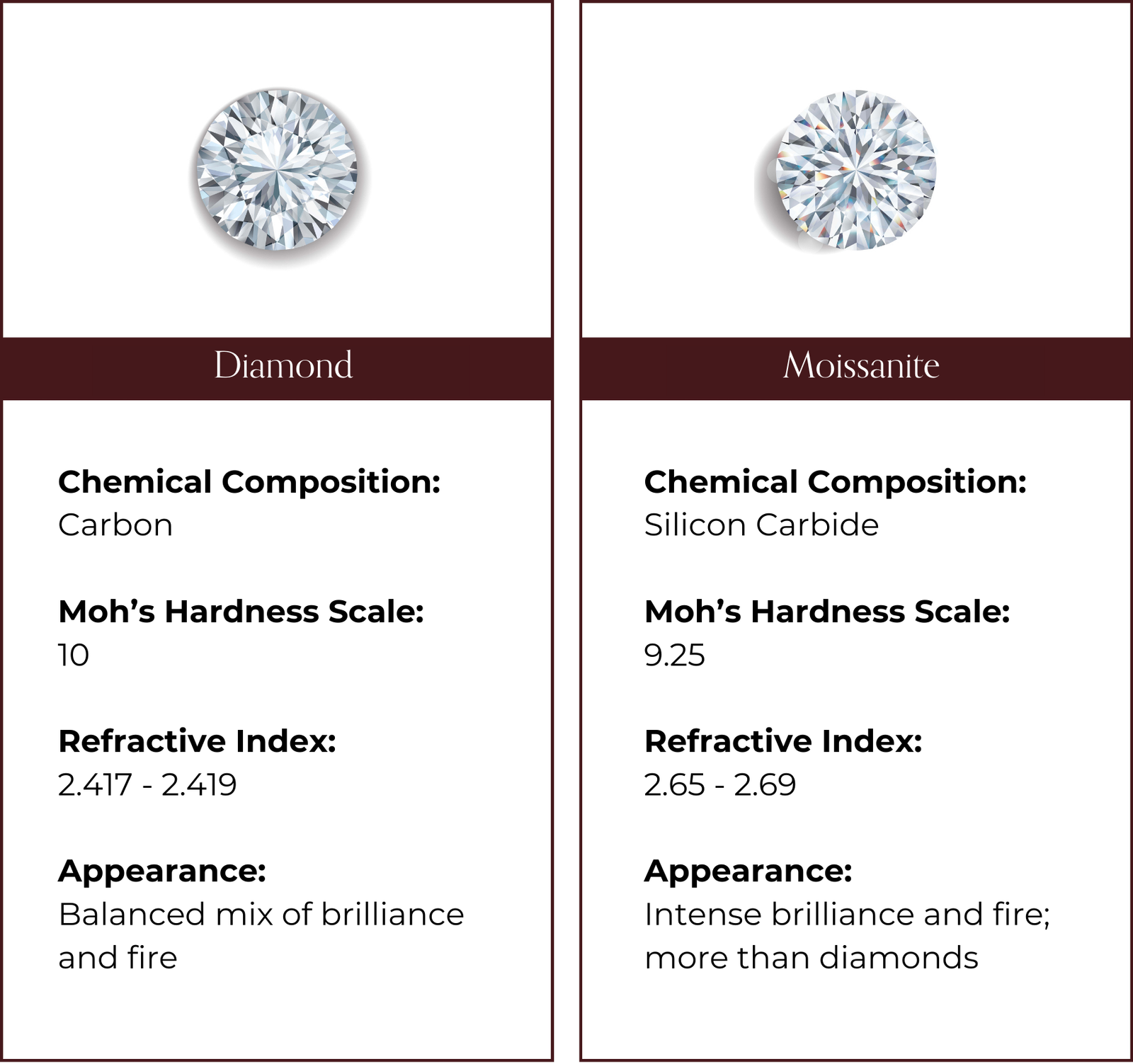Diamond vs Moissanite

From their timeless allure, diamonds have been long set as the standard stone for luxury and beauty. As a symbol of love and commitment, these gems have become the go-to choice for engagement rings, heirlooms, and other pieces of fine jewelry.
With their beauty, it’s only natural that the industry has created “diamond simulants” designed to mimic their appearance.
In this article, we’ll compare the main differences between diamonds and moissanite, to help you make an informed decision if you ever find yourself in a situation where you’re deciding between each.
While moissanite doesn’t carry the allure or value of a diamond, it is one of the most popular diamond simulants on the market today. As a gemstone, it does a great job at resembling a diamond in its own right, though it differs in terms of composition, brilliance and fire, and long-term value.
Moissanite and Diamonds: Inherently Different
Diamonds are natural gemstones made of carbon, renowned for their extreme hardness and brilliance.
Formed deep within the Earth’s mantle, under extreme conditions of intense pressure and heat, diamonds have captivated humans for centuries, and have become the most popular stone choice for fine jewelry around the planet.
Moissanite, on the other hand, is a gemstone that mimics the look of diamonds. It was first discovered in 1893 by a French scientist, Henri Moissan, within a meteorite crater in Arizona. He first thought his initial samples were diamonds, but later in 1904 he saw that they were indeed chemically different.
Whereas diamonds are made out of carbon, moissanite is made of silicon carbide. Given their rarity in nature, natural moissanite is too scarce for commercial use.
With this in mind, virtually all of the moissanite used within jewelry has to be created within a lab. It’s in these laboratory settings where the different aspects of moissanite can be altered to give off a specific appearance in order to make it look like a natural diamond stone.
While traditionally mined, it should be noted that diamonds can also be grown in labs as well, providing an identical gemstone at a more affordable price. Unlike moissanite, lab-grown diamonds are indeed real diamonds.
Brilliance and Fire: A Key Difference
Visually speaking, the main difference between diamonds and moissanite lies in how they reflect light.
Both these stones have different levels of brilliance and fire – brilliance refers to the white light that reflects from a gemstone, while fire refers to the dispersion of colored light into rainbow-like flashes.
This has to do with their refractive indexes, which measures how much light bends as it passes through the stone.
When light enters a clear gemstone like moissanite or diamond, it slows down due to being “bent” or “refracted” from the stone itself. This slowing down causes the light to split and disperse, creating the flashes of brilliance and fire that make gemstones sparkle.

Diamonds have a refractive index of around 2.4, and produce a “subtle” but unmistakable sparkle, offering a balanced mix of brilliance and fire. This hallmark sparkle is one of the signature appeals of diamonds that have made them so popular.
Moissanite, on the other hand, has a higher refractive index of around 2.6. This means it refracts and bends light more, which produces a more intense sparkle. The flashes of both white and colored light from moissanite often create a rainbow-like effect.
Ultimately, the difference in brilliance and fire is one of the most significant differences between diamonds and moissanite. Even though the increased brilliance and fire may sound good on paper, for some wearers, moissanite’s light play can be perceived as overly exaggerated and artificial when compared to a diamond.
Hardness
Unlike softer stones like Opal or Pearls, diamond and moissanite are both extremely hard stones, and as such are suitable for everyday wear on a variety of pieces.
Diamonds, the hardest known material on earth, score 10/10 on the Mohs scale of hardness.
Moissanite, on the other hand, is comparable and scores 9.25 on the Mohs scale. It is still a very durable gemstone and is more than hard enough to be used as the stone for everyday wear pieces, such as engagement rings.
Price and Value
Besides the brilliance and fire of the two stones, another significant difference between diamonds and moissanite is the price.
Diamonds, due to their extreme rarity and complex formation process, are naturally much higher in price and are stones with intrinsic value and worth.
For many buyers, diamonds represent both an emotional and financial investment, with the understanding that the stone will retain or even increase in value over time. High-quality diamonds are often passed down as heirlooms, contributing to their lasting significance.
Moissanite, by contrast, is more affordable. Since moissanite for jewelry is virtually all made in a lab, the intrinsic value of the stone is less. Also, because moissanite’s cut, color, and clarity can be altered during its creation process, increasing the quality of these metrics wouldn’t necessarily lead to a more expensive stone. On the market, moissanite can cost anywhere between 80-90% less than a diamond of similar size and appearance.
For those seeking a budget-friendly option, moissanite can be a great choice, but it’s important to remember that it doesn’t carry the same allure or investment potential as a natural diamond.
In Conclusion
Both diamonds and moissanite come with their own advantages. Choosing between them, in the end, depends on your own preferences and priorities.
Diamonds are timeless and carry with them value that extends beyond just their beauty. With their natural rarity and intrinsic worth, they have the potential to become treasured heirlooms. They carry with them an unmistakable sparkle that even the best moissanite stones can’t exactly capture. They offer both sentimental and financial investment potential, making them an ideal choice for those seeking something with tradition and worth.
Moissanite, by comparison, gives a budget-friendly alternative for those who are looking for something flashy and aesthetic – without the investment value of a diamond. Even though they are diamond simulants that try to reproduce the look of a diamond, they are still beautiful in their own right.
Ultimately, your decision should reflect your priorities. If you’re looking for something that can be passed down through generations and will hold its value as a natural gem, a diamond would be the ideal choice. If you’re looking for something that looks nice and is to be worn as a fashion statement, a moissanite stone could be a candidate. At the end of the day, no choice is wrong, and both stones offer choices to be part of a piece that can be cherished and loved.



